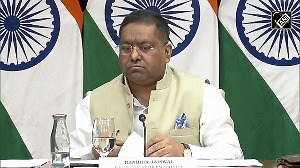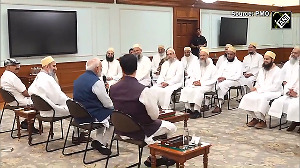He's built a larger-than-life image as a dream merchant who makes multi-star, megabuck extravaganzas.
He set a new Bollywood record by pouring Rs 15 crore (Rs 150 million) into the production of Taal which went on to become a blockbuster hit. So, why is Subhash Ghai messing with an itsy-bitsy Rs 2 crore (Rs 20 million) film called Jogger's Park?
Don't worry. There's a method in Ghai's madness. Firstly, his Mukta Arts is now a listed company and Ghai is answerable to shareholders. So, he's eager to hedge his bets and not put all his money on one big blockbuster.
Says the sapnon ka saudagar Ghai: "As an organisation we decided to take a portfolio approach to movie making. So we will be making small, medium and big budget films. Also their success ratio is high as the costs are low and therefore risks are mitigated."
Ghai isn't the only one who's turning the camera in a different direction and thinking small. Stung by the consistent string of megaflops, Bollywood's dream merchants are desperately hunting for a new winning formula that will ensure box-office bonanzas.
They are desperately conscious that 96 per cent of the big budget movies made in the last two years have sunk without a trace.
A remarkably large number of film-makers have concluded that the best way forward is to play safe and produce low-budget films that cost anywhere between Rs 1 crore (Rs 10 million) and Rs 5 crore (Rs 50 million).
Many of these are targeted at niche audiences in the metros. Alternatively, some film-makers are going even further and making 'crossover' movies in English targeted at affluent urban dwellers and international NRI audiences.
An extraordinarily large number of production houses have opted for the 'small is bountiful' strategy.
Take Pritish Nandy Communications which struck celluloid gold with blockbuster Kaante.
Despite Kaante's success, PNC isn't attempting another megamovie for the time being. Instead, it has lined up two low-budget crossover films, which will debut this year.
Then, there's Metalight Productions which made its mark with Satta and is now aspiring for greater things.
Metalight is shooting four low-budget films which each cost less than Rs 5 crore (Rs 50 million).
And producer Sunil Muthreja floated Channel Nine Entertainment to make films for less than Rs 1 crore (Rs 10 million).
Inevitably, the success of low-budget films is changing the entire structure of the industry and the types of films that are made. It is opening new possibilities like the one that was grabbed by Percept Pictures, a newcomer to the movie industry.
Its children's film Makdee made for under Rs 1 crore (Rs 10 million) has been a hit and Percept, which is part of an advertising and event management company, is now about to start shooting its second film.
Says Shailendra Singh, managing director, Percept Picture Company: "We realised that no films for children had been made in the last 24 months in India and this was a large untapped audience."
Says film trade analyst Amod Mehra: "Last year there were around 4-5 crossover films. This year I already know of more than 30, which are all set to hit the screen this year. And as far as niche low budget films are concerned they are in hundreds."
So what explains the rush? Firstly, there's a new generation of filmmakers who are desperately keen to hedge risks. Take Metalight for instance, which had the choice of making one megamovie for Rs 15 crore (Rs 150 million) or producing three with the same money.
Says Ajay Shanghavi executive director: "Even if one of the small budget films becomes a hit we are through. So the risks are spread out."
Shanghavi says that distributors are happier with this structure because if one of the movies flops Metalight can make up for it by offering a second at a discount.
Shanghavi's views are endorsed by leading distributors. Shringar Films, in fact, has already distributed over a dozen small budget films.
"At least 90 per cent of small films provide us with big money. By comparison, the success of medium or big budget films is at best 50 per cent," says Utpal Acharya head, north India.
The economics of the new game isn't tough to understand. To take one example: it cost Rs 2.5 crore (Rs 25 million) to make Mr and Mrs Iyer.
By contrast it took around Rs 2 crore (Rs 20 million) according to industry sources to shoot one Kareena Kapoor song-and-dance sequence in Khushi.
Says Rongita Nandy, creative director and producer, PNC: "In small budget or crossover films the costs are lower on every territory and therefore the risks are lower."
Of course, numerous factors have come into play as movie producers start to think small. There's an acute shortage of saleable stars who can pull in the audiences.
Points out Sanjay Bhattacharjii chief operating officer of UTV Motion Pictures: "Top stars like Shah Rukh Khan, Aamir Khan, Salman are all booked for 12-18 months. And producers don't want to make movies with mediocre stars. So they have no option but to go for niche low budget or cross over films which look less risky."
What has added to the viability of these niche films is the proliferation of multiplexes all over the country and especially in metros.
At last count there were around 30 multiplexes scattered around the country and over 100 more are expected to come up in the next few months.
Says trade analyst Komal Nahata: "Multiplexes with their smaller auditoriums provides such films an opportunity to be screened which did not exist earlier. With seating capacities of 100-300 the viability of a single show improves for the exhibitor compared to showing it on large 600-1,000 seater halls."
The multiplexes make better economics for everyone concerned in the film business. Exhibitors charge around Rs 1.2 lakh (Rs 120,000) a week for a small auditorium that seats 150 people.
That compares with Rs 5 lakh (Rs 500,000) for a 350-seater hall. And, since ticket prices are higher in multiplexes the exhibitor has enough cash to share with the distributor.
"The multiplex system has also helped small producers clearly target their films. We don't need to make films for a pan-Indian audience but for the niche affluent audience who wants to see quality cinema," says Amita Madhvani, CEO, Shiftfocus, a film production company started by admen Sumantra Ghosal and Ram Madhvani which made Let's Talk.
Then, there's the battle between the television channels which is helping all moviemakers.
In the last few months the TV companies have been paying more than ever before for small screen rights. Add to that the fact that the thriving international circuit is also keen on movies with middle-class themes.
Sunil Muthreja, CEO of Channel Nine Entertainment, which produced and distributed films like American Desi and Freaky Chakra for instance, has recovered over 70 per cent of his cost from overseas and satellite rights.
Similarly, Percept sold the TV rights of Makdee to Zee and raked in about 30 per cent of the film's costs from the deal.
The satellite companies which are fighting their own battles are forking out anywhere between Rs 5 lakh (Rs 500,000) and Rs 30 lakh (Rs 3 million) even for small budget films.
So, many producers are hoping that even a moderate run in India combined with TV and the international circuit will take them into the black.
That's the calculation made by Pratap Raju, co-founder of Bandra West productions and producer of cross-over film Bas Yun Hi: "We hope that overseas rights and satellite and music sales would account for 90 per cent of the investment and we would be in profits if the film does reasonably well in the eight cities where it will be released in the first phase."
The low budget film makers are also tapping new markets -- like non-English speaking countries.
Triplecom for instance has sold a dubbed version of Mr and Mrs Iyer in Italy for around $20,000. Similarly there are other opportunities.
Says Raju: "Four Indian channels have recently been launched in Indonesia and there's a dire need for content for such audiences. This is where the opportunities are growing."
There are, of course, critics who don't believe that small is beautiful -- or profitable.
Nahata believes that only a few small budget movies have actually made reasonable profits. "They have got a lot of publicity and critical acclaim but not necessarily business," Nahata says.
Others argue that making small films is even more risky than putting money on a blockbuster. They point out that it's tougher to get backing for small films and they can't be pre-sold. "So if you fail you are down under," says Bhattacharjii.
Of course producers and exhibitors are well aware of these problems. Some exhibitors are already dropping prices to woo audiences.
For instance Fame Adlabs in Mumbai is targeting younger audiences through a 10:30 am morning show and selling tickets for only Rs 30 -- half of what it costs for regular shows.
Producers are also paring costs wherever possible. Metalight for instance produces three films in a row so that it can save costs.
That way it is cheaper to hire cameras and other equipment. Says Shanghavi: "We save around 15 per cent to 20 per cent in overhead cost as we can command discounts on post production by making combined deals for all the three films, recycle sets and so on."
The small producers are also trying to cut costs in other ways. For instance, they are trying to use less film during shoots.
Says Rupali Mehta: "A lot of time is spent at the pre-production stage. We conducted a workshop with the actors to avoid any kind of on-shoot mistakes that would waste film."
The economics of small movie making is, of course, entirely different from taking a mega-production to market. On way to cut costs is to make fewer prints.
Each print costs between Rs 30,000 and Rs 40,000.
So, for instance, Shringar made only 25 prints of Mr and Mrs Iyer. By contrast, big films like Kaante had a staggering 500 prints.
But small budget films are not compromising on publicity budgets -- which range from 15 per cent to as much as 30 per cent of what is spent on making the film.
But unlike the big budget banners they are making effort to market their products more innovatively.
The producers of Let's Talk even went to the extent of staging a mock husband-wife battle in Mumbai's Oxford Book Store. Once the squabble had attracted everyone's attention the producers introduced the cast and the film.
Last year movies like Legend of Bhagat Singh cost between Rs 15 crore (Rs 150 million) and Rs 18 crore (Rs 180 million) and barely recovered 15 per cent to 25 per cent of costs.
The message is clear: It's becoming tougher than ever before to score a megahit at the box-office. Will the small budget be the answer to Bollywood's difficulties? That isn't entirely sure but the cameras are rolling.
Additional reporting by Soumik Sen and Anusha Subramaniam






 © 2025
© 2025